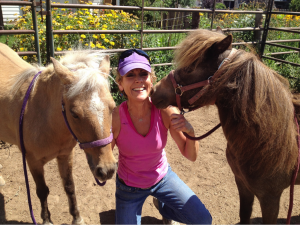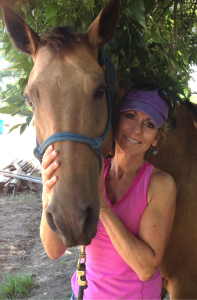
Author Michele with ‘the girls’: Giselle and Akikio
“There is evidence that children maltreated in the preverbal stage may have difficulty expressing themselves through symbolism (Thompson, 1999) and therefore find it difficult to play out their trauma in therapy using dolls or role-play. Animals represent reality, yet at a safe psychological distance, allowing children to work through their trauma issues within interactions with beings that live—actually eat, move around, show emotions, have offspring, become sick, and even die” (as cited in Bachi, Parish-Plass, 2017, pg 2).
Boaz, an 82 pound Husky/Black Labrador mix, performs his soft talk “Woof” and Down Dog Yoga pose, before settling his hind end in the lap of a laughing mother just as we begin our parent/child session on the floor. Boaz instinctively knows that the young child is not very interested in his assistance; however, he is well attuned to the mother’s need for humor and comfort. At times, Boaz thinks he is a lap dog. Perhaps he could benefit from some proprioception work! A young boy wraps his arms around Boaz’s neck and buries his face in the dog’s thick, soft-coated neck. Boaz releases his happy sneeze and the child giggles as he wipes dog-slobber specks from his face. The client feels accepted, loved, and in that moment … the world is an okay place.
“Chandler (2005) identified some of the major AAT therapy techniques. These can include: (1) allowing clients to pet, touch, and hug an animal when the need or desire may arise; (2) using the animal to enhance the quality of the therapeutic relationship; (3) using the animal as a “co-therapist” to reflect, paraphrase, clarify, and summarize the behaviors and expressions of the therapy dog, the client, and the interactions between them; and (4) using the animals to provide access to emotions.“ (as cited in Thompson, 2009).
During a Family Theraplay Session, the opening activity focuses on relationship repair using positive affirmations, while tossing a yarn ball from person to person to create a visible connection. Soon enough Boaz saunters to the center of the circle and begins catching strands of yarn that stream above his head. Laughter fills the room as Boaz continues playful interactions with various family members. Each of them is reminded that the family can have fun together and that love can be felt again. As a group, we tap into the experience for greater enhancement and future recollection. Surrounded by grassy hills, open fields, a trickling stream, and towering evergreens, Joseph, the tall, dark, and handsome Missouri Fox Trotter gelding, gently lowers his head as the child moves closer. Joseph offers a sensitive ear that captures the whisper of this young boy, who believes his pain is too unbearable for the human ear. We employ mounted work as part of mindfulness techniques to address emotional self-awareness needs, and use Havening during the dismounted/ground work. Joseph moves intuitively closer to the boy, who is seated on a stool in the middle of the round pen, and I guide the client in self Havening Touch through mirroring the process. Joseph nuzzles the boy’s knee, then his cheek. It keeps the child feeling supported and valued. We capitalize on mastery skills that the child had developed during the Equine-assisted sessions, which help keep him distracted from the disturbing feeling but in a positive manner. The client taps in his most favorite part of the session, cinching up (pun intended) another meaningful session … for all. Some background The terms Animal Assisted Therapy (AAT) and Animal Assisted Psychotherapy (AAP) are often used interchangeably, with Animal Assisted Play Therapy (AAPT) being distinguished for the use of Play Therapy. Equine Assisted Therapy (EAT) and Equine Assisted Psychotherapy (EAP) are also used interchangeably. Equine Assisted

Michele with Joseph
“Leaders in the field of therapy with maltreated children are showing interest in the potential of AAP for the healing process (Eliana Gil in Sori & Schnur, 2013; Perry in ChildTrauma Academy, 2016). For instance, a recent therapy approach for the treatment of children suffering from maltreatment and trauma focuses on the effects of trauma on a child’s neurodevelopment (Perry, 2009). The Neurosequential Model of Therapeutics (NMT) takes into accounts the key systems and areas in the brain affected by adverse developmental experiences. Perry (2014) identifies therapeutic goals in four functional domains that are meant to reach these areas of the brain and have a reparative effect on them. Perry suggests that AAP may help reach three of these domains (sensory integration, self-regulation, and relational) (ChildTrauma Academy, 2016). In addition, AAP may also lead to the integration of the related areas of the brain (J. Pfeiffer, 2016, personal communication), which is essential in the healing of the child suffering from trauma (Siegel, 2003),” as cited in (Bachi, Parish-Plass, 2017, pg 3).
About our team: Boaz is a Certified Canine Good Citizen (CGC) Level I (and behaves as such most of the time) and a Registered Therapy Dog. He is currently over-actively pursuing his CGC Level II and Certified Therapy Dog credentials. His owner lags behind, still lost without her leash somewhere in Basic Training …. Joseph has been providing children with therapeutic experiences since March 2014, and looks forward to many more years of connecting with young ones. He never ceases to amaze his owner/mom. Emmett was a constant support, a vital therapeutic connection, and a source of humor for two years, until he transcended to the Heavenly Animal Kingdom in November 2016. I would be remiss and thoroughly chastised by some who keep whinnying in the background, if I did not mention the rest of our therapeutic team: Giselle and Akikio (both Class B Miniature Mares who had provided therapeutic experiences for over 20 years! They are now in semi-retirement, but are willing to work for anything edible as long as they don’t have to disclose their ages); and our newest and flashiest addition, Paloma (a 10- year-old Peruvian Paso mare, who is still trying to determine her left hoof from her right, and whose only real issue is that her love knows no boundaries). Thank you for reading and I hope you enjoyed your ‘visit’ with us as much as I had sharing it with you. References Bachi, K. & Paris-Plass, N. (2017). Animal Assisted Psychotherapy: A unique relational therapy for children and adolescents. Clinical Child Psychology and Psychiatry, Vol. 22(1) 3-8. Doi: 10.1177/135104516672549 Compelling counseling interventions: VISTAS 2009 (pp. 199-209). Alexandria, VA: American Counseling Association. Siegel D. (2003). An interpersonal neurobiology of psychotherapy: The developing mind and the resolution of trauma. In Solomon M., Siegel D. (Eds.), Healing trauma: Attachment, mind, body, and brain. New York, NY: Norton Theraplay Institute https://www.theraplay.org/index.php/about-tti Thompson, M. J. (2009). Animal-assisted play therapy: Canines as co-therapists. In G. R. Walz, J. C. Bleuer, & R. K. Yep (Eds.) Compelling counseling interventions: VISTAS 2009 (pp. 199-209). Alexandria, VA: American Counseling Association Resources https://www.ncbi.nlm.nih.gov/pmc/articles/PMC4454536/ http://www.neurologyadvisor.com/therapies animals-therapy-psychological-mental-health benefits-depression-anxiety-ptsd/article 473330/3/ VanFleet R., Faa-Thompson T. (2014). Animal assisted play therapy to empower vulnerable children. In Green E., Myrick A. (Eds.), Play therapy with vulnerable populations: No child forgotten (pp. 85–103). Lanham, MD: Rowman & Littlefield

